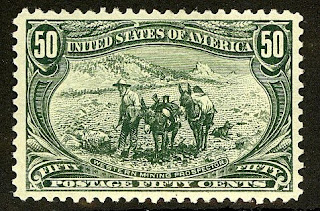
"One man's faith is another man's fortune." The axiom not only re
fers to televangelists, cult leaders, Afterlife insurance salesmen, New Age gur

us, and other purveyors of theological snake oil, but also has possible implications for the philatelic investor.
Religion on stamps is the sixth most popular topical collecting area in the U.S., according to a survey done by the
American Topical Association. While comparable data for the world as a whole is unavailable, it is likely that Religion ranks high among the world's most popular collecting topics. Aside from the normal criteria for determining whether to invest in a particular issue (described in my earlier article, "
Practical Advice: Stamp Investment Criteria"), three more are useful when considering topicals related to a particular religion:
1) the population of adherents worldwide;
2) economic trends affecting that population, especially growth of a middle class;
3) the growth/decline of the religion and/or level of interest/participation among its members (the data cited below is for 2000-2005, and is from Wikipedia's article- "
Major Religious Groups);
Each of the major religions represent potential sources of demand for the topicals that relate to them, and the characteristics of the markets created by their adherent/collector populations differ. A detailed analysis would be advisable as preliminary to investing funds in any of them, but for now we'll make do with a brief overview. Several of the "belief systems" described below reside in a gray area between religion and philosophy, but qualify for consideration because they've adopted theocentric or spiritual elements since their inception, and more importantly, because they inspire devotion among hundreds of millions of followers. I've listed the belief systems in order of member population.
1) Christianity (approximately 2 billion to 2.2 billion adherents) : from a philatelic investment perspective, a mixed bag; according to Wikipedia, the number of Christians grew by a rate of 1.32% from 2000 to 2005 - less than the population growth rate of the world as a whole (1.41%). While there are themes which may be popular to Christians generally (Old/New Testament scenes, religious figures/saints, churches, holidays) the heterogeneity of the religion and its demographic subtrends necessitates a closer look at its main branches.:
- a) Roman Catholicism (approx. 1.2 billion) - growing in the U.S., and prevalent in much of the developing world - Latin America, the Philippines, some parts of Africa; related topicals should be bolstered by economic growth in these areas;
- b) Protestantism (approx. 600 million) - prevalent in much of Northern Europe, the U.S., making inroads in Latin America and Africa;
- c) Orthodox Churches (approx. 300 million)- prevalent in Russia, much of Eastern Europe, and Greece; related topicals represent a bet on the economic development of Russia and the Slavic and part-Slavic nations of Eastern Europe;
2) Islam (approx. 1.6 billion)- according to Wikipedia, Islam is the fastest growing major religion in the world, with a 2000-2005 growth rate of 1.84%. Even more compelling is the placement of the religion mostly within nations throughout Asia, Africa, and Australasia that should continue to enjoy rapid economic development over the coming decades. It should be noted that as the secularist Western belief in the "separation of Church and State" is not generally recognized in Islam, prominent Moslems need not be religious leaders in order to qualify as subjects for Islamic topical stamps. Other likely subjects include: mosques, minarets, and other holy sites, and Islamic art.
3) Hinduism (approx. 900 million)- the fourth fastest growing religion in the world (1.57% from 2000-2005). Hinduism topicals will likely be bolstered by India's rapid economic growth. Topics include: Hindu gods, religious figures, holy places/temples.
4) Buddhism (estimates range from 350 million to about 1 billion) - Buddhist topicals should be bolstered by the rapid economic development of the Far East; it also has a foot in the door in the West, as it is beginning to attract converts among the middle and upper classes; Topics include: the Buddha and Bodhisattvas (Buddhist saints), temples.
5) Confucianism/Taoism (approx. 400 million)- widespread in China , and the countries culturally influenced by China (Taiwan, Korea, Vietnam), all of which are likely to prosper over the long-term; topics include: Confucius, Lao Tze, holy places/shrines, etc..
6) Shinto (approx. 40 million)- the prospects for Shintoism Topicals are wholly dependent upon the growth of stamp collecting in Japan. Topics include: holy sites, shrines.
7) Sikhism (approx. 26 million)- the third fastest growing religion (2000-2005 rate of 1.62%), and significant in that most adherents live in India, and will participate in that country's projected explosive economic growth. Topics include: Guru Nanak, prominent Sikhs, temples/holy sites.
8) Judaism (approx. 16 million) - the World Jewish population is static; however, a relatively high percentage of Jews collect stamps; also, certain Old Testament themes may appeal to Christian collectors as well; Israel is popular, of course, and topics include: prominent Jews, holidays, Jewish history.
9) Jainism (approx. 10 million)- most live in India, which has issued a few stamps commemorating prominent Jains and temples.
10) Bahai Faith (approx. 7.5 million) - the world's second fastest growing religion (1.72% from 2000-2005); worldwide dispersion- about 35% live in India, and 5% in Iran; currently, I am not aware of any stamps honoring the religion.
11)
Cao Dai (approx. 4 million) - I note this Vietnamese religion mainly because of Vietnam's stellar economic growth over the last few decades, and its prospects for even greater prosperity in the years to come.
In summary, whether one is a believer, an agnostic, atheist, or convert to the insidious new cult of stamp collecting, the philatelic investor may be truly blessed if he worships at the altar of demographic data regarding religions, and always makes the trend his friend.









































